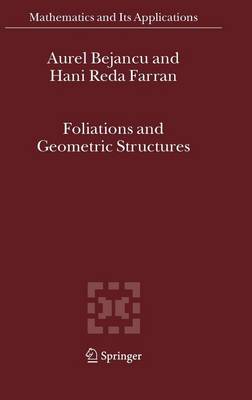Mathematics and Its Applications
3 primary works
Book 364
Lightlike Submanifolds of Semi-Riemannian Manifolds and Applications
by Krishan L Duggal and Aurel Bejancu
Published 29 February 1996
This book is about the light like (degenerate) geometry of submanifolds needed to fill a gap in the general theory of submanifolds. The growing importance of light like hypersurfaces in mathematical physics, in particular their extensive use in relativity, and very limited information available on the general theory of lightlike submanifolds, motivated the present authors, in 1990, to do collaborative research on the subject matter of this book. Based on a series of author's papers (Bejancu [3], Bejancu-Duggal [1,3], Dug gal [13], Duggal-Bejancu [1,2,3]) and several other researchers, this volume was conceived and developed during the Fall '91 and Fall '94 visits of Bejancu to the University of Windsor, Canada. The primary difference between the lightlike submanifold and that of its non degenerate counterpart arises due to the fact that in the first case, the normal vector bundle intersects with the tangent bundle of the submanifold. Thus, one fails to use, in the usual way, the theory of non-degenerate submanifolds (cf. Chen [1]) to define the induced geometric objects (such as linear connection, second fundamental form, Gauss and Weingarten equations) on the light like submanifold. Some work is known on null hypersurfaces and degenerate submanifolds (see an up-to-date list of references on pages 138 and 140 respectively). Our approach, in this book, has the following outstanding features: (a) It is the first-ever attempt of an up-to-date information on null curves, lightlike hypersur faces and submanifolds, consistent with the theory of non-degenerate submanifolds.
Book 527
Geometry of Pseudo-Finsler Submanifolds
by Aurel Bejancu and Hani Reda Farran
Published 31 October 2000
Finsler geometry is the most natural generalization of Riemannian geo- metry. It started in 1918 when P. Finsler [1] wrote his thesis on curves and surfaces in what he called generalized metric spaces. Studying the geometry of those spaces (which where named Finsler spaces or Finsler manifolds) became an area of active research. Many important results on the subject have been brought together in several monographs (cf. , H. Rund [3], G. Asanov [1], M. Matsumoto [6], A. Bejancu [8], P. L. Antonelli, R. S. Ingar- den and M. Matsumoto [1], M. Abate and G. Patrizio [1] and R. Miron [3]) . However, the present book is the first in the literature that is entirely de- voted to studying the geometry of submanifolds of a Finsler manifold. Our exposition is also different in many other respects. For example, we work on pseudo-Finsler manifolds where in general the Finsler metric is only non- degenerate (rather than on the particular case of Finsler manifolds where the metric is positive definite). This is absolutely necessary for physical and biological applications of the subject.
Secondly, we combine in our study both the classical coordinate approach and the modern coordinate-free ap- proach. Thirdly, our pseudo-Finsler manifolds F = (M, M', F*) are such that the geometric objects under study are defined on an open submani- fold M' of the tangent bundle T M, where M' need not be equal to the entire TMo = TM\O(M).
Secondly, we combine in our study both the classical coordinate approach and the modern coordinate-free ap- proach. Thirdly, our pseudo-Finsler manifolds F = (M, M', F*) are such that the geometric objects under study are defined on an open submani- fold M' of the tangent bundle T M, where M' need not be equal to the entire TMo = TM\O(M).
Book 580
Foliations and Geometric Structures
by Aurel Bejancu, PhD, Hani Reda Farran, and Bejancu Aurel
Published 22 November 2005
The theory of foliations of manifolds was created in the forties of the last century by Ch. Ehresmann and G. Reeb [ER44]. Since then, the subject has enjoyed a rapid development and thousands of papers investigating foliations have appeared. A list of papers and preprints on foliations up to 1995 can be found in Tondeur [Ton97]. Due to the great interest of topologists and geometers in this rapidly ev- ving theory, many books on foliations have also been published one after the other. We mention, for example, the books written by: I. Tamura [Tam76], G. Hector and U. Hirsch [HH83], B. Reinhart [Rei83], C. Camacho and A.L. Neto [CN85], H. Kitahara [Kit86], P. Molino [Mol88], Ph. Tondeur [Ton88], [Ton97], V. Rovenskii [Rov98], A. Candel and L. Conlon [CC03]. Also, the survey written by H.B. Lawson, Jr. [Law74] had a great impact on the de- lopment of the theory of foliations. So it is natural to ask: why write yet another book on foliations? The answerisverysimple.Ourareasofinterestandinvestigationaredi?erent.The main theme of this book is to investigate the interrelations between foliations of a manifold on one hand, and the many geometric structures that the ma- foldmayadmitontheotherhand.
Amongthesestructureswemention:a?ne, Riemannian, semi-Riemannian, Finsler, symplectic, and contact structures.
Amongthesestructureswemention:a?ne, Riemannian, semi-Riemannian, Finsler, symplectic, and contact structures.


